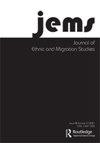Global education trajectories and inequality: STEM workers from China to the US
IF 2.8
1区 社会学
Q1 DEMOGRAPHY
引用次数: 4
Abstract
ABSTRACTThe United States has become reliant on workers from abroad to meet its demand for the knowledge-based economy. However, some migrants may face an earnings deficit relative to similar US-born workers. This paper examines the sources of the deficit and asks whether we should expect the initial deficit to disappear with education attainment and work experience in the US. They are challenging to answer as few data sources measure and track market experiences and educational trajectories of migrants over time. Migration and educational trajectories which reflect the country's source of formal educational credentials as well as other forms of capital may explain the deficit, this study applies sequence analysis to the National Science Foundation’s ‘National College Graduate Survey’ to examine earnings differences between China- and US-born STEM workers. After identifying the dominant migration-education profiles for these STEM workers, I show that the wages of migrants with exclusively China-based education are 5–25% lower than those of workers with at least some US-based education, even among workers who are otherwise similar in terms of experience, legal status, employer type, occupation, degree level and time since migration. These findings point to significant and lasting penalties due to non-US education.KEYWORDS: Migrationeducationintellectual migrationtrajectorysequence analysis Disclosure statementNo potential conflict of interest was reported by the author(s).Notes1 College educated, either with STEM-related education or work in a STEM occupation.2 NSCG takes a stratified sampling strategy to maximize its coverage of different demographic, education and occupation groups (National Center for Science and Engineering Statistics Citation2019)3 Due to the extremely small sample size, the fifth highest degree is omitted in the analysis.4 Job-Skill Match is derived from the ‘OCEDRLP’ variable in the NSCG dataset, measuring to what extent is the respondent’s work is related to their highest degree. Higher score denotes a closer match.5 Due to data compression in the public-use NSCG dataset, the geographic unit in this analysis is limited to countries and census divisions; the institution identifier is limited to the 1994 Carnegie classification codes; citizenship and visa type are restricted to citizen/non-citizen/naturalized citizen, and temporary/permanent visas.6 Age 25–65 is selected to capture working age population with college education per ACS standard; see US Census Bureau (Citation2020) for detail.7 To reduce the complication in the optimal-matching distance calculation and trajectory clustering process, this study has adopted country code as the indicator of education location, STEM/STEM-related/non-STEM broad group codes for field of study, and 1994 Carnegie code for institution identifier.8 I have tested multiple sequence analysis fit statistics such as the silhouette score and elbow method, and the results all point to the four-type solution.9 The details of the five US-born trajectories will not be discussed here since they are not the main point of this analysis. See appendix 1 for additional detail and visualization of US-born sequences.10 I use non-linear curves here because STEM worker’s wages don’t necessarily follow the traditional age-earnings profiles. See Deming and Noray (Citation2018) for details.11 The NSCG data provide a retrospective education history of the respondent that dates back from the person’s highest to fifth highest higher education degrees. The fifth highest degree is omitted in the sequence analysis due to the limited sample size. Hence, the starting point of these visualizations should be interpreted as the respondent’s fourth highest degree instead of first degree, as they may have more than four degrees.全球教育轨迹与不平等:从中国到美国的STEM工作者
摘要知识经济时代,美国对外来劳动力的依赖日益加深。然而,与美国出生的同类工人相比,一些移民可能面临收入赤字。本文考察了赤字的来源,并询问我们是否应该期望最初的赤字随着美国的教育程度和工作经验而消失。这些问题很难回答,因为很少有数据来源可以衡量和跟踪移民的市场经验和教育轨迹。移民和教育轨迹反映了国家正规教育证书的来源以及其他形式的资本可以解释赤字,本研究将序列分析应用于美国国家科学基金会的“全国大学毕业生调查”,以检查中国和美国出生的STEM工人之间的收入差异。在确定了这些STEM工人的主要移民教育概况之后,我表明,完全在中国接受教育的移民的工资比至少接受过一些美国教育的工人的工资低5-25%,即使是在经验、法律地位、雇主类型、职业、学位水平和移民后时间方面相似的工人也是如此。这些发现表明,非美国教育对学生造成了重大而持久的惩罚。关键词:移民教育、智力移民轨迹、序列分析披露声明作者未报告潜在利益冲突。大专学历,具有STEM相关教育或从事STEM职业NSCG采用分层抽样策略,以最大限度地覆盖不同的人口、教育和职业群体(National Center for Science and Engineering Statistics Citation2019)。3由于样本量极小,在分析中省略了第五高度工作技能匹配来自NSCG数据集中的“OCEDRLP”变量,衡量受访者的工作与他们的最高程度相关的程度。得分越高表示比赛越接近由于公共使用NSCG数据集的数据压缩,本分析中的地理单位仅限于国家和人口普查区;机构标识符限于1994年卡内基分类代码;公民身份和签证类型仅限于公民/非公民/归化公民,临时/永久签证选择25-65岁是为了捕获按ACS标准受过大学教育的工作年龄人口;详见美国人口普查局(Citation2020)为了减少最优匹配距离计算和轨迹聚类过程的复杂性,本研究采用国家代码作为教育地点的指标,采用STEM/STEM相关/非STEM广泛组代码作为研究领域,采用1994年卡内基代码作为机构标识符我测试了多个序列分析拟合统计,如剪影分数和肘部法,结果都指向四种类型的解决方案这五个美国出生的轨迹的细节将不会在这里讨论,因为它们不是本分析的重点。有关美国出生的基因序列的更多细节和可视化,请参见附录1我在这里使用非线性曲线是因为STEM工作者的工资不一定遵循传统的年龄收入概况。详见Deming and Noray (Citation2018)NSCG数据提供了被调查者从最高到第五高等教育学位的回顾性教育历史。由于样本量有限,在序列分析中省略了第五高度。因此,这些可视化的起点应该被解释为被调查者的第四个最高度,而不是第一个度,因为他们可能有四个以上的度。
本文章由计算机程序翻译,如有差异,请以英文原文为准。
求助全文
约1分钟内获得全文
求助全文
来源期刊

Journal of Ethnic and Migration Studies
Multiple-
CiteScore
7.80
自引率
9.10%
发文量
157
期刊介绍:
The Journal of Ethnic and Migration Studies (JEMS) publishes the results of first-class research on all forms of migration and its consequences, together with articles on ethnic conflict, discrimination, racism, nationalism, citizenship and policies of integration. Contributions to the journal, which are all fully refereed, are especially welcome when they are the result of original empirical research that makes a clear contribution to the field of migration JEMS has a long-standing interest in informed policy debate and contributions are welcomed which seek to develop the implications of research for policy innovation, or which evaluate the results of previous initiatives. The journal is also interested in publishing the results of theoretical work.
 求助内容:
求助内容: 应助结果提醒方式:
应助结果提醒方式:


